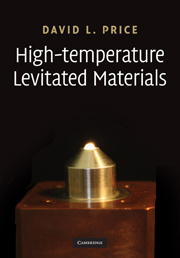5 - Levitation in materials research
Published online by Cambridge University Press: 23 April 2010
Summary
Advantages of levitation methods
Investigations of contained materials at high temperature have to contend with two distinct problems: (a) interactions between the sample and container and the resulting possibility of contamination, and (b) the effects of the container walls on the measurements, causing, for example, additional background and beam attenuation in scattering experiments. Both types of problem are removed by the use of levitation. Figure 5.1 shows the melting points and sound velocities (in the solid phase) of some representative materials. Levitation methods (with laser or other kinds of heating) are generally advantageous for measurements at temperatures above the line marked ‘levitation’. This is of course especially true for liquids, but levitation may also be beneficial for studying solid phases at high temperature. For corrosive materials, including many oxide melts, levitation methods may also be advisable at lower temperatures.
The regions marked ‘n’ and ‘x’ in Fig. 5.1 indicate roughly the regions where inelastic neutron and X-ray scattering, respectively, will be advantageous for studying collective excitations, taking into account the higher energy resolution of neutron spectrometers as opposed to the greater ability of X-ray experiments to sample larger regions of Q and E, given the requirement that the velocity of the probe must be considerably larger than that of the excitation being studied (Price & Sköld, 1986).
In the following three chapters we will give some examples of such investigations in different kinds of high-temperature solids and liquids.
- Type
- Chapter
- Information
- High-Temperature Levitated Materials , pp. 66 - 70Publisher: Cambridge University PressPrint publication year: 2010

